The Skylake Core i3 (51W) CPU Review: i3-6320, i3-6300 and i3-6100 Tested
by Ian Cutress on August 8, 2016 9:00 AM ESTLegacy Benchmarks
Some of our legacy benchmarks have followed AnandTech for over a decade, showing how performance changes when the code bases stay the same in that period. Some of this software is still in common use today.
All of our benchmark results can also be found in our benchmark engine, Bench.
3D Particle Movement v1
3DPM is a self-penned benchmark, taking basic 3D movement algorithms used in Brownian Motion simulations and testing them for speed. High floating point performance, MHz and IPC wins in the single thread version, whereas the multithread version has to handle the threads and loves more cores. This is the original version, written in the style of a typical non-computer science student coding up an algorithm for their theoretical problem, and comes without any non-obvious optimizations not already performed by the compiler, such as false sharing.

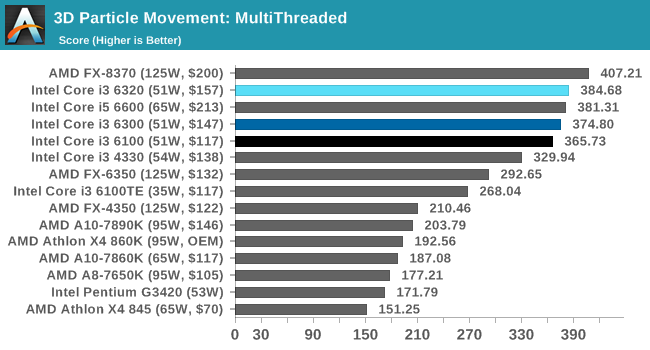
With un-trained programming skills comes a myriad of results. 3DPMv1 is not cache bound, but highly affected by false sharing and IPC. Our Core i3 staircase is in effect, and AMD is badly affected requiring 8 threads to match/beat an i3. In our v2 results, the spread is a more believable, which goes to show that having the right programming paradigm (even just a couple of lines of code) can make a large difference.
CineBench 11.5 and 10
Cinebench is a widely known benchmarking tool for measuring performance relative to MAXON's animation software Cinema 4D. Cinebench has been optimized over a decade and focuses on purely CPU horsepower, meaning if there is a discrepancy in pure throughput characteristics, Cinebench is likely to show that discrepancy. Arguably other software doesn't make use of all the tools available, so the real world relevance might purely be academic, but given our large database of data for Cinebench it seems difficult to ignore a small five minute test. We run the modern version 15 in this test, as well as the older 11.5 and 10 due to our back data.
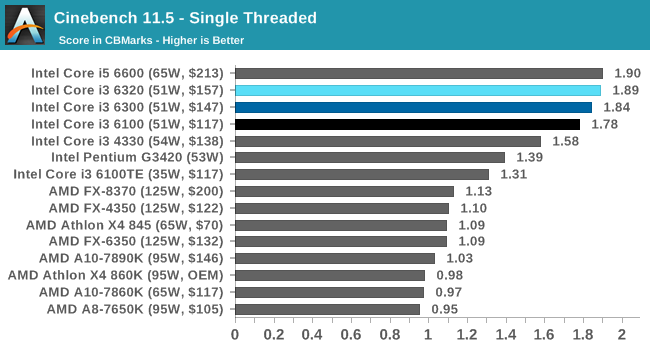
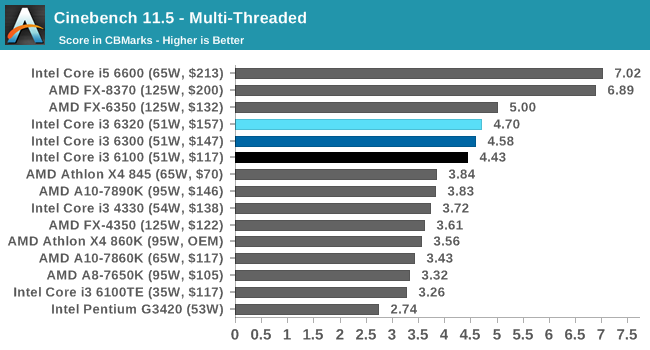
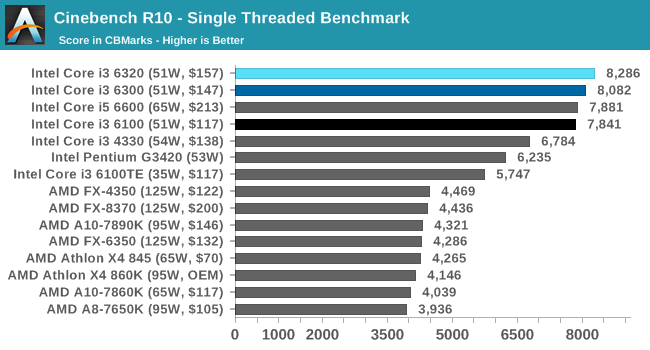

The older CB results mirror the CB15 test, albeit more compressed.
POV-Ray 3.7
POV-Ray is a common ray-tracing tool used to generate realistic looking scenes. We've used POV-Ray in its various guises over the years as a good benchmark for performance, as well as a tool on the march to ray-tracing limited immersive environments. We use the built-in multithreaded benchmark.
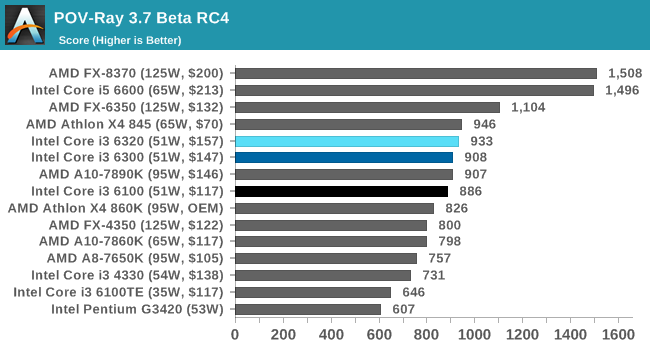
AMD gets a better showing in POV-Ray, with the $70 X4 845 going ahead of all of our Core i3 parts, and the older A10 sitting in between them. The older FX parts, despite their age, take advantage of the multi-threaded nature of the benchmark.
TrueCrypt 7.1
Before its discontinuation, TrueCrypt was a popular tool for WindowsXP to offer software encryption to a file system. The almost latest version, 7.1, is still widely used however the developers have stopped supporting it since the introduction of encrypted disk support in Windows 8/7/Vista from 5/2014, and as such any new security issues are unfixed.
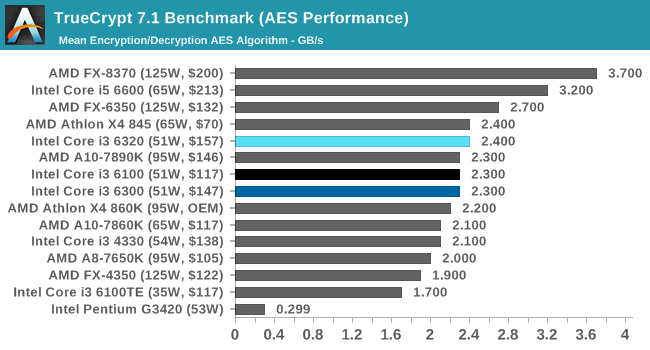
x264 HD 3.0
Similarly, the x264 HD 3.0 package we use here is also kept for historic regressional data. The latest version is 5.0.1, and encodes a 1080p video clip into a high quality x264 file. Version 3.0 only performs the same test on a 720p file, and in most circumstances the software performance hits its limit on high end processors, but still works well for mainstream and low-end. Also, this version only takes a few minutes, whereas the latest can take over 90 minutes to run.
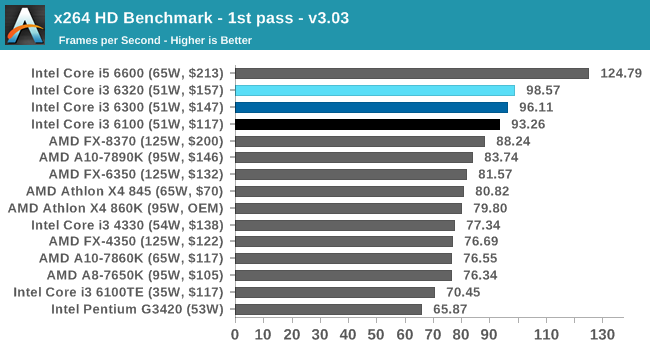
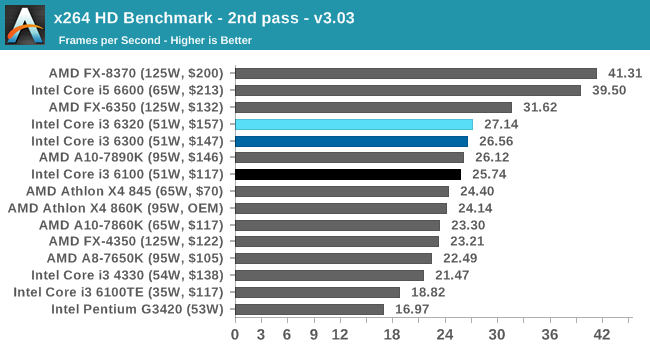
7-zip
7-Zip is a freeware compression/decompression tool that is widely deployed across the world. We run the included benchmark tool using a 50MB library and take the average of a set of fixed-time results.
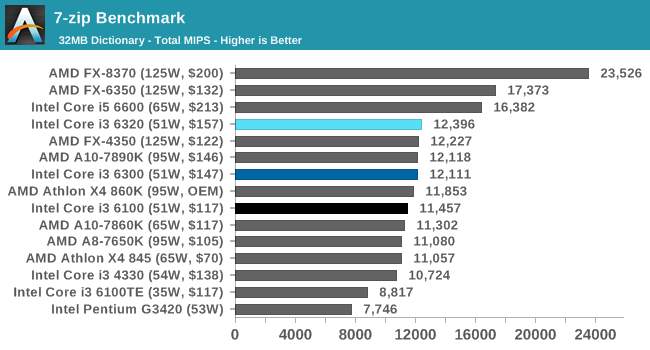










94 Comments
View All Comments
Morawka - Monday, August 8, 2016 - link
It's still suprising to see it on a low end CPU. i didnt know the i3's had ECC, now i'm thinking of building a FREENAS box off of one of theseSamus - Tuesday, August 9, 2016 - link
You'd be surprised how many servers actually ship with i3's...those HP ML10's are incredibly common and I've seen a number of Lenovo SMB servers run i3's.The i3 is more than adequate for most small business servers unless they plan to run Hyper-V. Most other CPU intense services are cloud-based now (I personally think a business is crazy to maintain their own exchange server these days when Microsoft offers a $4/month/mailbox turn-key solution)
Basically all servers do now is run the domain and a few basic services like file sharing and routing. SQL, Exchange, even Hyper-V are all inexpensive Azure\Office365 services. It really comes down to who costs more, your IT guy, or Microsoft. Odds are, the IT guy. Unfortunate because I am one.
jardows2 - Monday, August 8, 2016 - link
Low end consumer CPU's. Intel likes the product segmentation between Xeon's and i5/i7. This is also why Intel forced the use of the "c" series chipsets for the Xeon processors. a Xeon E3-1240 v5 is about $30.00 cheaper than an i7 6700, with a higher base frequency, but slightly lower turbo frequency.Of course, this helps people who are wanting server grade, but only need low end processing power. A Pentium or an i3 would be a great home server chip, but i5 or i7 overkill. If you are wanting to use a higher-end production computer with ECC, you probably are looking at higher-end processors than i5 or i7 anyway.
However, AMD includes the support in all their AM3+ processors, and I believe in all their FM2 processors as well. Not every motherboard supports it.
sheh - Monday, August 8, 2016 - link
Yes, I was referring to non-server CPUs.But why is it on the i3? Not that I mind, but the surprising aspect and the problem is that it's not on i5 and i7.
Black Obsidian - Monday, August 8, 2016 - link
jardows2 covers that in his/her product segmentation reference.If you want ECC on the low end, Intel is happy to sell you an i3. If your needs are any higher, Intel wants to push you towards a Xeon (and C-series chipset), which IIRC are higher-margin parts than the i5 and i7, and happen to have gone through additional server-related validation.
satai - Monday, August 8, 2016 - link
I understand this concept but I still don't get why there are cheap ECC enabled i3s instead of more expensive (but still cheaper than 4C Xeons) dual-core Xeons...extide - Monday, August 8, 2016 - link
Yeah, that is kinda weird, you would think Intel would do that, and create even more segmentation, which is something they definitely tend to like to do.rhysiam - Monday, August 8, 2016 - link
My guess would be (and full disclosure... this an educated guess): at some point the market becomes too niche and the higher profit margins get lost to the additional costs of segmenting product lines, keeping different lines in stock, etc. The cheapest Xeon quad core on Newegg is already only $90 more than the cheapest i3. How much more could Intel actually charge for a dual core Xeon over the i3, the only benefit of which is ECC? Then they'd have to maintain a whole new product line, manage stock levels, etc. My guess is that for the relatively small number of customers pairing a dual core with ECC memory, it's just more trouble than it's worth.satai - Tuesday, August 9, 2016 - link
Thet sounds like a believable explanation.DanNeely - Monday, August 8, 2016 - link
What exactly is the point of the Core i3-6098P supposed to be? Compared to the equally priced I3-6100, it's slower, has a weaker GPU, and a higher TDP. On paper I can't see any reason to buy the former instead of the latter?